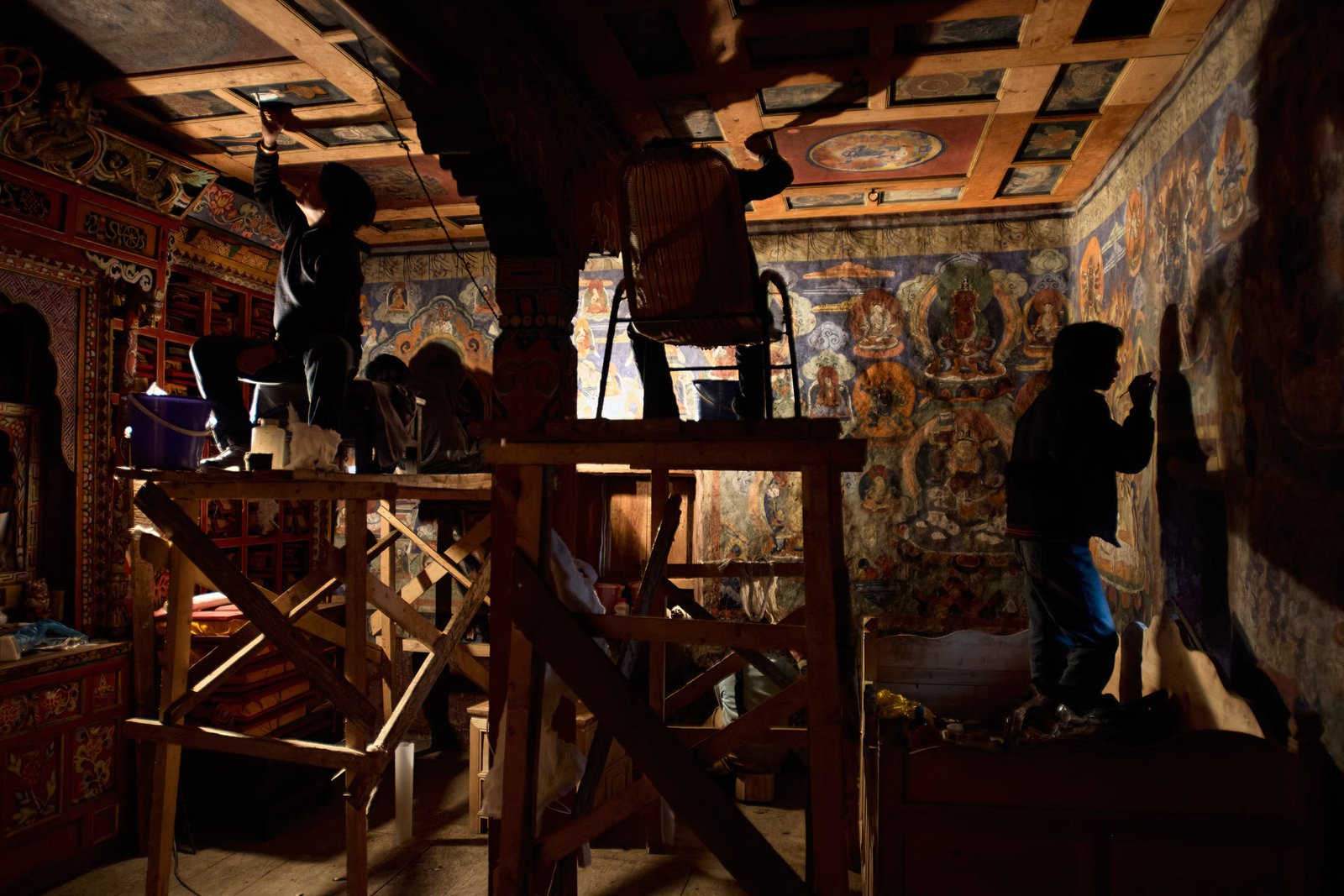The chapel is situated in the third floor of Mr Gelek’s house, in the village of Wayao, in the Sichuan region. The restoration project was part of the training program sponsored by the Kham Aid Foundation, supported by Winrock International, Millepede Foundation and private donors and carried out in collaboration with John Sanday Associates. A local team composed by 11 trainees carried out the preservation of the wall paintings. The local team received guidance from Luigi Fieni and 5 members of the Wall Painting Conservation Team of Mustang, Nepal.
gelek's chapel

state of preservation
The pictorial cycle of the chapel was painted directly on a wooden separation wall on the north side where some water leakage had partly washed away some of the paint layer. The paintings on west and south wall were painted on a thin layer of clay, with a varying thickness because of the different shapes of the underneath stone based wall. On the east side, a wooden altar stands with its carved and painted panels and cupboards. The ceiling was made out of interlocked and painted wooden panels. The architrave and the pillars were painted as well.
The structural wall of this chapel was made of stones piled up apparently without binder. A coating of clay mixed up with straw was applied to create the flat surface, hosting the pictorial layer. The thickness of this coating varied according to the voids left by the construction stones. One side of the pictorial cycle was painted on a wooden wall made of planks joined together with glue. The binder of the paint layer is water based in all the three painted walls. A water-soluble varnish was applied so as to protect the wall paintings. The paint layer was extensively covered by a coating of clay. Where the paintings were lying on a render, the latter was randomly detached from the stone based wall. The wall paintings had no varnish at all. A darkened varnish was present only where the paint layer was applied onto the architrave, the pillars and the altar. The paint layer, where visible, was damaged by scratching and accidental losses. The main images painted on the wooden ceiling were covered by a thin coating of clay as well.
intervention of restoration
The consolidation: it was carried out after the coating of mud had been removed. To achieve that, toothbrushes were used together with the aid of specific fiberglass pencils for restoration. The same procedure was employed to clean off the clay from the ceiling. The consolidation procedure consisted in two phases: consolidation of the preparatory layers and consolidation of the paint layer. The former was achieved by injecting, by syringe, an acrylic emulsion in water: a surfactant solution had to be injected before the gluing emulsion. The latter consisted in fixing the flaking of the paint layer with an acrylic emulsion mixed with acetone. Wet Japanese tissue paper had to be applied by brush in the area where the flaking of paint layer occurred. Then a surfactant solution was spread by brush. Subsequently, the acrylic emulsion was applied by brush and let it to set for some minutes. The paint layer flakes were then thoroughly pushed back using sponges or spatulas wrapped in cotton. The procedure ended with the removal of eventual excess of the acrylic emulsion from the paint layer, achieved by carefully pressing a sponge soaked in distilled water onto the Japanese tissue paper, which was then removed and the paint layer left to dry. Since the amount of water in any mortar or solution will evaporate, some detachments could still not sound still underneath the surface of the wall paintings. Thence, the consolidation was checked every few weeks for all the length of the project and more injections were carried out where and when needed.
The cleaning: the lower section of the murals presented areas covered with soot and grime. Those areas were cleaned with cotton swabs soaked in organic chemicals. The level of cleaning needed to be balanced because some areas were cleaned and other still had traces of varnish. Those areas were cleaned alternating an EDTA disodium solution mixed with Arabic gum through Japanese tissue paper. In some cases, a mixture of organic chemicals was used directly on the paint layer for the former solution was not effective enough. The procedure ended with the application of a bland layer of Arabic gum, applied through Japanese tissue paper in 3% solution in order to enhance the original brightness of colours.
The plastering: cracks, fissures and holes were plastered up to the level of paint layer with a PVA binder solution mixed with a local clay. The surface had to be previously wet with weak PVA solution in water in order to enhance the adhesive power of the plaster.
the end
Unfortunately the project was stopped in 2008 following a ban imposed by the Chinese Government in all Tibetan areas soon after the infamous riots broken out in Lhasa and Chengdu in occasion of the Olympic Games. All of a sudden foreigners were not allowed anymore to work in sensitive areas, thus influencing the destiny of this project. Later on the foundation supporting the project closed down and the project could never be finished.


















